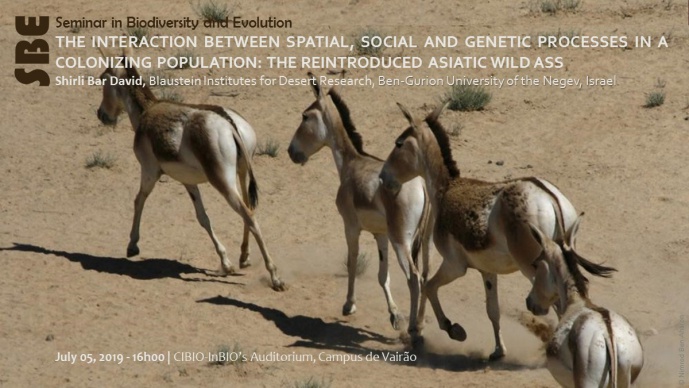THE INTERACTION BETWEEN SPATIAL, SOCIAL AND GENETIC PROCESSES IN A COLONIZING POPULATION: THE REINTRODUCED ASIATIC WILD ASS


Colonization of species, the process in which species spread to new areas, is receiving increasing attention because of its conservation implications. Reintroductions of species can be considered as 'large scale experiments’ to examine colonization. The Asiatic wild ass (Equus hemionus) was reintroduced into Israel between 1982-1993 (‘founding population’). This provided a research opportunity to investigate the development of genetic structure of the species within a short period, and to evaluate the effect of spatial and social patterns on this process. Since reintroduction, the population of the Asiatic wild ass has been expanding its range and is currently distributed throughout the Negev concentrating around main water sources (‘population activity centers’). We combined behavioral observations, non-invasive genetic study and simulation modeling to examine the level of polygyny and male dominance stability of the wild ass, and to evaluate the spatial genetic structure of the Negev population. From direct observations in five breeding seasons, we found that ~20% of all males were dominant (the breeding males) and these remained dominant for several years. A simulation model, based on genetic data, support strong polygynous mating system (i.e. only few males contribute to the gene pool) which leads to a low variance effective population size. This low effective population size is of concern and management actions should improve this situation. Additionally, a population genetic structure was detected among activity centers. This structure could be a result of the interaction between social and behavioral patterns: the limited gene flow among activity centers is possibly due to strong site fidelity of dominant males coupled with potential founder effects during the population’s range expansion.
Dr Shirli Bar-David holds a PhD degree from the Tel-Aviv University, where she developed work on modeling population growth in time and space following reintroduction of the Persian Fallow Deer. As a post-doc she was involved in Environmental Science Policy and Management at the University of Berkeley, where she studied the dynamics of disease in colonizing populations and the space use patterns of African buffalo and the implications for disease dynamics. After that, she moved to the University of Haifa where she has dedicated her research to spatial ecology, integration of capture-recapture and population genetics of fire salamanders. Currently, she is a Senior Lecturer at the The Jacob Blaustein Institutes for Desert Research, from the Ben-Gurion University of the Negev, Israel, working with spatial ecology and spatial genetics and their implications for conservation biology and wildlife management. Since 2014, she is a commission member of the IUCN SSC Equid specialist group.
[Host: BIODIV PhD Students]
Image credits: Nimrod Ben-Aharon